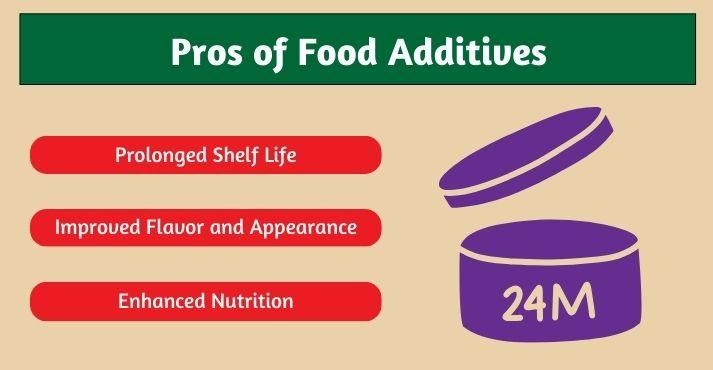Did you know that a single processed food item can contain more than ten ingredients that aren’t food? These extra substances, known as food additives, are used to improve taste, appearance, and shelf life in products we eat every day, from snacks and sodas to canned goods.
Knowing what food additives are can help consumers make better choices, and understanding these additives is essential for quality and safety for food service professionals.
Food additives also play a big role in today’s food supply, but knowing which ones may have harmful effects or are best avoided for better health is crucial.
This article will explore food additives, the types commonly used, and whether they’re safe to consume.
What Are Food Additives?
Food additives are substances added to food to boost its taste, texture, appearance, or shelf life. These ingredients might be natural, like salt and vinegar, or synthetic chemicals, like artificial colorants and preservatives.
Many foods we consume daily, especially processed ones, contain various additives to improve quality and maintain freshness. For instance, a soft drink may have flavor enhancers, while a canned soup might use food preservatives to prevent spoilage.
Food additives play a significant role in the food industry, making products more appealing and accessible for extended periods.
However, not all additives are equal. While some, like salt, have been safely used for centuries, others may have potential health risks, especially with frequent consumption.
Comprehending what food additives and ingredients to avoid is essential for consumers and food service professionals to make informed and safe choices.
Classification of Food Additives

Food additives can be found in nearly everything we consume today, from colorful candies and flavored snacks to canned goods and ready-made meals. But did you know that not all food additives are the same?
They vary in origin, purpose, and even safety, making it essential to understand their differences. Additives generally fall into two main categories: natural additives and artificial ones.
Knowing this classification can help consumers make informed decisions, especially when deciding what ingredients to avoid in food.
Natural vs. Artificial Additives
Natural additives are derived from plants, animals, or minerals. Examples include essential ingredients like salt, vinegar, and sugar—substances humans have safely used for centuries to preserve and flavor food.
In Southeast Asia, salt is a traditional preservative in dishes like salted fish. Salt can draw moisture out, slowing down bacterial growth and allowing the fish to be stored longer.
Other natural additives include herbs and spices, which add flavor and have some antimicrobial properties that help preserve certain foods.
Conversely, artificial additives are synthetic, meaning they’re created in laboratories to achieve specific effects.
For instance, sodium benzoate is an artificial preservative commonly used in bottled sauces, soft drinks, and other products to prevent spoilage. Unlike traditional preservatives like salt or vinegar, this chemical helps foods stay fresh longer but is lab-made.
Many processed foods contain a mix of natural and artificial additives. This combination helps manufacturers create tasty, visually appealing products with a longer shelf life.
However, understanding the difference between natural and artificial additives can guide consumers in choosing products that align with their health preferences and knowing what food additives to avoid.
Common Types of Food Additives

Food additives play a critical role in the food industry, enhancing everything from taste and appearance to shelf life and texture. Many foods would spoil quickly, lack flavor, or look less appealing without them.
Additives are everywhere: in your pantry, in local supermarkets, and nearly all processed foods.
However, understanding the different types of food additives and their specific roles can help consumers make informed choices about what ingredients to avoid in food and which ones are safe to consume in moderation.
Below, we summarize some of the most common food additives and their functions, with examples relevant to Southeast Asian cuisine and local products.
1. Preservatives
Preservatives are essential for extending the freshness of food by preventing spoilage caused by bacteria, mold, and yeast.
They allow items to stay on store shelves longer, which is especially valuable for foods like canned goods, sauces, and even some fresh produce that needs an extended shelf life.
Typical preservatives include sodium benzoate and nitrates, often found in processed foods due to their effectiveness in preventing spoilage and maintaining taste.
- Example: Many canned foods like ketchup contain preservatives to ensure they last longer without losing quality. According to canned food market insights, these additives help extend shelf life, providing consumers with safe and flavorful products even after extended storage.
2. Flavor Enhancers
Flavor enhancers intensify the natural taste of food, making it more appealing. The most well-known flavor enhancer is monosodium glutamate (MSG), which brings out the umami taste commonly enjoyed in Asian cuisines.
Another example is hydrolyzed vegetable protein, which enriches the savory profile of foods and makes them more satisfying.
- Example: In Singapore and across Southeast Asia, MSG is widely used in popular dishes for its unique flavor-enhancing properties. This practice is widespread in local dishes that strive for balanced, flavorful profiles, adding depth to soups, sauces, and stir-fries.
3. Color Additives
Color additives are used to make food visually appealing, which can influence taste perception and consumer choice. These additives, like caramel coloring, may be natural or synthetic, like Red 40.
Vibrant colors in food products can make them more attractive, especially in candies, desserts, and beverages, where color plays a big role in presentation and appeal.
4. Emulsifiers and Stabilizers
Emulsifiers and stabilizers improve the texture and consistency of food. They help blend ingredients that would only occasionally mix well, like oil and water, ensuring a uniform product.
Common emulsifiers include lecithin and guar gum, frequently added to dressings, sauces, and ice cream to keep the texture smooth and consistent.
5. Sweeteners
Sweeteners are traditional sugars or sugar substitutes that add sweetness without extra calories. Artificial sweeteners like aspartame and sucralose are popular among those managing calorie intake or blood sugar levels, providing sweetness without the glycemic impact of sugar.
How Food Additives Are Regulated?
The safety of food additives is a primary concern for consumers and industry professionals. To address this, various regulatory agencies worldwide oversee and regulate the additives used in food products. Key organizations include:
- FDA (United States): The S. Food and Drug Administration reviews food additives before they are released into the market, assessing them for potential health risks and setting limits on their use.
- EFSA (Europe): The European Food Safety Authority performs scientific assessments of food additives, analyzing their safety and determining whether they meet European standards for consumption.
- Singapore Food Agency (SFA): The SFA ensures that common ingredients in our food, including additives, meet strict safety standards for Singapore consumers.
These agencies use a comprehensive safety framework to evaluate each additive’s Acceptable Daily Intake (ADI), as we will explore in detail ahead.
In Singapore, the SFA monitors the presence of food preservatives and other additives in local products. The SFA (Singapore Food Agency) helps ensure that Singaporean foods comply with national health standards by evaluating food safety practices and conducting tests.
These evaluations are often part of broader food safety audit procedures, which play a critical role in maintaining compliance and accountability. This rigorous oversight protects consumers and upholds food quality.
Through these regulatory efforts, consumers can enjoy a wide variety of foods while knowing their safety has been thoroughly assessed and monitored by trusted agencies.
Are Food Additives Safe to Consume?
The safety of food additives is a key topic in nutrition and health. For most additives, safety is determined by the Acceptable Daily Intake (ADI), a standard developed by regulatory agencies to guide safe consumption.
The ADI indicates the amount of a specific additive that can be consumed daily over a lifetime without causing health issues. This standard assures that most additives used within these guidelines are considered safe for consumers.
However, certain artificial ingredients in food may pose risks if frequently consumed in large amounts, especially in processed foods.
For example, additives like sodium nitrate (commonly used in processed meats) have been associated with potential health concerns, such as increased cancer risk, if consumed excessively over time.
Artificial sweeteners, like aspartame, are another example: while generally recognized as safe within the ADI, high intake might raise concerns for some individuals, especially those with pre-existing health conditions.
For this reason, consumers need to know what ingredients to avoid in food to maintain a balanced diet. Prioritizing whole, unprocessed foods can naturally help reduce the intake of harmful food additives.
Additionally, checking food labels and understanding common ingredients in our food can guide safer choices. Some people may also find they have specific sensitivities to certain additives, like colorants or preservatives, and may experience side effects such as headaches or digestive issues.
In short, while food additives are generally safe when consumed within regulated limits, it’s wise to monitor intake, especially with highly processed foods.
Making informed decisions by understanding food additive examples and reading labels carefully can help consumers balance the convenience of additives with a commitment to long-term health.
Pros and Cons of Food Additives
Food additives are widely used in the food industry to make products more appealing, safer, and longer-lasting. However, they have benefits and potential drawbacks.
Knowing these can help consumers make better choices about the foods they consume and recognize what ingredients to avoid in food for their health.
Benefits of Food Additives

1. Prolonged Shelf Life
One primary reason for using food preservatives and other additives is to extend the shelf life of products. This ability to keep foods fresh longer is essential in reducing food waste and maintaining food security.
For instance, canned goods and packaged snacks often contain preservatives to prevent spoilage, ensuring they can last on store shelves and in pantries for weeks or months.
When making products last longer, additives help reduce the frequency of waste, which is beneficial not only for consumers but also for retailers and producers who aim to minimize product losses due to spoilage.
2. Improved Flavor and Appearance
Additives such as flavor accompaniments and colorants make food more enjoyable and visually appealing, significantly enhancing the overall eating experience.
For instance, monosodium glutamate (MSG) is widely used to bring out savory flavors in dishes, especially in Southeast Asian cuisine. Similarly, color additives, like Red 40, make foods visually vibrant, which can impact consumers’ perceptions of taste.
The use of additives helps ensure that foods meet consumer expectations for taste and appearance, which is especially important in processed and ready-to-eat foods. Colorants, for example, make candies, beverages, and baked goods visually enticing, attracting consumers of all ages.
3. Enhanced Nutrition
Some food additives improve the nutritional value of foods, making them beneficial for health-conscious individuals.
Fortification additives, such as added vitamins and minerals, help address potential dietary deficiencies, particularly in products aimed at children or people with specific health goals.
For instance, breakfast cereals, dairy products, and bread are often fortified with essential nutrients like vitamin D, calcium, and iron.
Fortified foods can be particularly beneficial in regions with common nutrient deficiencies, as they provide an accessible means for the population to consume necessary nutrients.
Potential Drawbacks of Food Additives

1. Health Risks
Although additives are generally safe within regulated limits, there are concerns about the health risks associated with certain artificial ingredients in food when consumed in excess.
For example, sodium nitrate, a preservative used in processed meats, has been linked to potential health issues, including high blood pressure and an increased risk of cancer with high intake.
Similarly, artificial sweeteners like aspartame may be problematic for people with specific sensitivities or medical conditions.
Over time, frequent consumption of processed foods high in these additives can lead to health risks, making it essential to recognize food additives to avoid for those aiming to minimize potential harm.
Moderation and awareness are essential, as certain additives may contribute to health issues if consumed excessively.
2. Allergenic Reactions
Some people have sensitivities or allergies to specific additives, which can cause reactions ranging from mild discomfort to severe responses. Food allergens are sometimes present in additives like preservatives, colorants, and flavor enhancers.
For instance, sulfites, commonly used in wines and dried fruits to prevent spoilage, can trigger asthma-like symptoms in some people.
Other common allergens may include artificial colorants, which are linked to reactions such as rashes or digestive discomfort in sensitive individuals.
Consumers prone to allergies should carefully check food labels and be aware of common ingredients in our food that may provoke reactions.
3. Environmental Impact
Beyond health considerations, the environmental impact of food additives is another area of concern. Many synthetic chemicals, including certain preservatives and colorants, can adversely affect the environment if not properly managed.
These chemicals may be released during production as waste, potentially contributing to water and soil pollution.
Additionally, the production and disposal of some additives involves processes that require energy and resources, which may not be sustainable.
For instance, artificial colorants are often derived from non-renewable petroleum. This could contribute to environmental challenges, particularly if the waste generated needs to be disposed of responsibly.
Conclusion
Food additives are integral to modern food production, offering benefits like extended shelf life, increased flavor, and improved nutritional value.
By understanding what food additives are, consumers can better navigate the ingredients commonly found in processed foods.
While many common ingredients in our food are considered safe within regulated limits, some artificial ingredients may carry risks if overconsumed. Knowing what ingredients to avoid in food, such as certain preservatives and artificial sweeteners, helps us make healthier choices.
A balanced approach to food additives allows consumers to enjoy their convenience and variety while minimizing potential health and environmental impacts.
For those mindful of long-term well-being, prioritizing whole foods and reading ingredient labels can support a healthier, more informed diet.
With this awareness, consumers can enjoy the benefits of additives without compromising safety and sustainability.





























